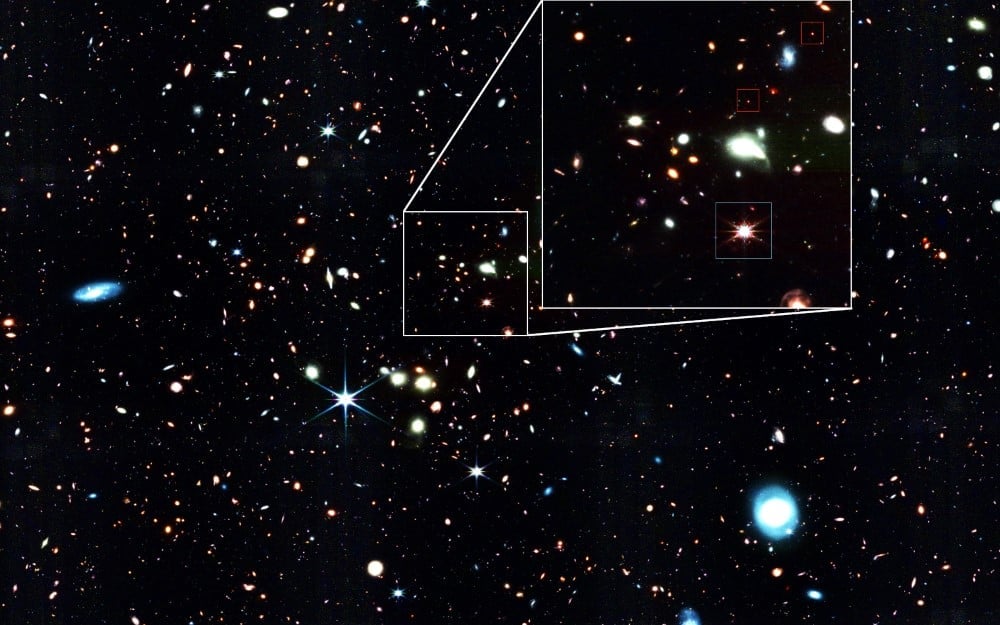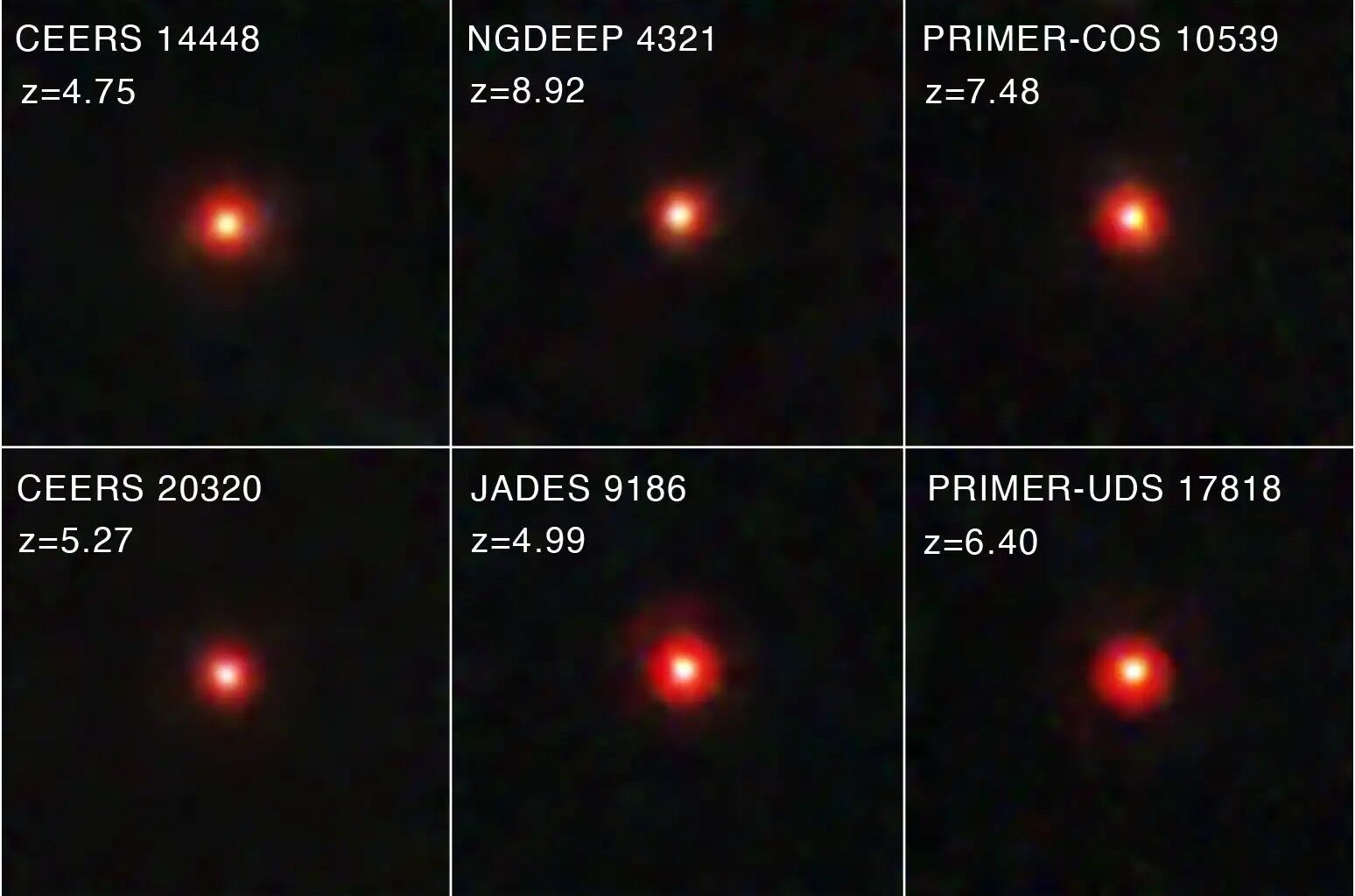When the James Webb Space Telescope (JWST) began operations, one of its earliest surveys was of galaxies that existed during the very early Universe. In December 2022, these observations revealed multiple objects that appeared as “Little Red Dots” (LRDs), fueling speculation as to what they might be. While the current consensus is that these objects are compact, early galaxies, there is still debate over their composition and what makes them so red. On the one hand, there is the “stellar-only” hypothesis, which states that LRDs are red because they are packed with stars and dust.
This means that they could be similar to “dusty galaxies” that are observed in the Universe today. On the other hand, there is the ” MBH and galaxy” theory, which posits that LRDs are early examples of Active Galactic Nuclei (AGNs) that exist throughout the Universe in modern times. Each model has significant implications for how these galaxies subsequently evolved to become the types of galaxies observed more recently. In a recent paper, an international team of astronomers considered the different scenarios. They concluded that LRDs began as “stellar only” galaxies that eventually formed the seeds of the supermassive black holes (SMBHs) at the center of galaxies today.
The research was led by Andres Escala, a Professor of astronomy from the Universidad de Chile. He was joined by colleagues from the Astronomical Computing Institute at the University of Heidelberg, Yale University, and the Sapienza University of Rome. The paper detailing their findings, “On the Fate of Little Red Dots,” is currently under review for publication in the* Astrophysical Journal*.
The discovery of LRDs has mystified astronomers, as they possess certain characteristics reminiscent of modern-day astronomical objects, but with some notable differences. For instance, the “stellar only” interpretation posits that LRDs are intensely star-forming, dusty galaxies with extremely dense core regions. This theory explains why these galaxies appear so compact and red, two of the most distinguishing features of LRDs. However, the widths of their hydrogen spectral line emissions (Balmer-series lines) suggest velocity dispersions much higher than those observed in early galaxies, which would lead to long-term instability.
 *Webb image showing the early galaxies it detected during its Cycle 1 General Observations. Credit: NASA/ESA/CSA*
*Webb image showing the early galaxies it detected during its Cycle 1 General Observations. Credit: NASA/ESA/CSA*
In contrast, the MBH interpretation is supported by the presence of broad Balmer emission lines, which are suggestive of massive black holes at their centers. However, most LRDs do not appear to emit a significant amount of X-ray radiation (which is typical for quasars), and the black holes thought to be present are overmassive with respect to their host galaxies. Nevertheless, as Professor Escala told Universe Today via email, these two explanations are considered the most likely for two reasons:
In addition to there being strong evidence, these two predominant interpretations are considered “less exotic” than the alternatives. Nevertheless, LRDs are still objects that have never been observed before at low redshift values (z). The BH and galaxy interpretation is favorable because such objects are “normal” in the local Universe but with different “weights.” In the local universe, the MBH mass is 0.1% of the galactic mass; however, for LRDs, it would be 10% of the host galaxy (a factor of 100 larger). The stellar-only interpretation for LRDs states that they could be just another galaxy like any other in the Universe, but with a big difference: at least 10 times smaller than the smallest galaxies previously observed (100pc vs 1kpc) and with a considerably larger mass.
In contrast, Escala and his colleagues began with the stellar-only interpretation, but considered how LRDs could evolve to fit the BH and galaxy interpretation. Their theory would unify these two interpretations by suggesting that they represent different evolutionary stages of these early galaxies. As Escala noted, their theory is supported by essentially the same evidence as the BH and galaxy interpretation. This includes how few LRDs are detectable in X-rays compared to quasars in the more recent Universe:
Within the evolutionary path proposed in our paper, the lack of X-rays basically tells us that most LRDs are in the early stages of such evolution. The transitory nature of LRDs (only appearing in the Universe between z=8 and 4, equivalent to 10% of the age of the Universe) might support that these objects can only be observed in their early stages, evolving later to systems (or components of them) more similar to the ones observed at lower redshifts.
In short, their theory posits that LRDs will eventually host an MBH because, even under the stellar-only interpretation, the extreme densities of LRDs imply that a fair fraction of their inner regions will eventually form a massive black hole that will be over-massive with respect to the host. This evolutionary approach to LRDs offers a more comprehensive explanation for Webb’s observations of the early Universe. This could have significant implications for our current models of cosmology and galactic evolution, which have been challenged by the recent discovery of these highly compact and deep red galaxies. Said Escala:
It means that LRDs are probably the most favourable places for MBH formation. Even if these systems are only composed of stars, our work implies that such a stellar system cannot be stable (at least in its inner regions) and would inevitably tend to form MBHs. Complementing this with the other proposed scenarios, in all possibilities, LRDs will be places for ongoing or recently formed MBHs, given that their formation is one of the most open problems in structure formation and cosmology.
Further Reading: arXiv

